How To Repair Baked-on Paint On Aluminum Boat Hull

Ensuring the Longevity of Paint When Applied Over Aluminum Components
April 2022
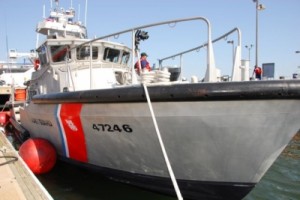
Military, commercial, scientific and a few recreational vessels congenital using aluminum alloy ofttimes utilize the un-painted approach, and with practiced reason
The next time ane passes your fashion, take a close wait at the Usa Declension Guard'due south heavy weather rescue vessel, the venerable 47-human foot Motor Life Boat or MLB. Or, any of their other aluminum response arts and crafts including the very latest 45-foot Response Gunkhole Medium or RBM, one of which I recently ocean trialed (its all electronic control system utilizes a joy stick rather than captain wheel, which is perfect for today's teenage recruits). Check out the paint job on these aluminum vessels. What y'all'll detect is, other than the familiar diagonal crimson, white and blue Coastie stripe and bottom antifoulant, these vessels are un-painted. Although the Coast Guard is well known for its thriftiness, this approach saves more than only the cost of the pigment. In the long run, it saves the Declension Guard and any other aluminum vessel operator that follows this pigment-complimentary protocol untold sums in paint, metal maintenance and repair as well as increasing the service life of alloy vessels. Hard to believe? Read on.
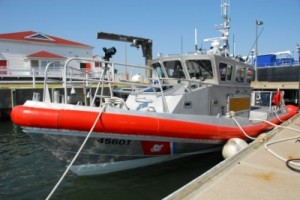
When left uncoated, aluminum is, with some caveats, naturally corrosion resistant
Although technically an element, with the symbol AL, most aluminum that's in employ (as opposed to ingot course) is actually an blend, having been mixed with various other elements such as copper, zinc, magnesium, manganese and silicon. The marine grades of aluminum, 5000 and 6000 series are alloyed exclusively with magnesium or magnesium and silicon, any other alloying elements increment corrosion potential.
Aluminum is the nigh widely used not-ferrous metallic; production worldwide is roughly 31 million tons annually, surpassed only by iron and steel. While a full word of the different types and alloys of aluminum and their various strengths and weaknesses are beyond the scope of this discussion, suffice it to say that aluminum is commonly used and desirable cloth for fabricating, in improver to entire vessels, all fashion of hardware and products, from hatches and window frames to tanks, cranes and motor mounting structures.
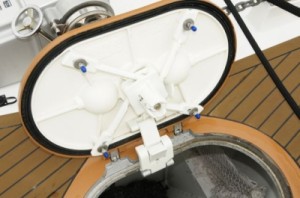
The uses for aluminum hardware aboard, both painted and unpainted, are nearly endless
There are several reasons for aluminum's popularity, chief amidst these are its high forcefulness to weight ratio, it possesses merely one third the density of steel, along with its natural resistance to corrosion. Unlike steel, without paint or whatsoever other coatings it remains relatively corrosion free. When aluminum is exposed to air or oxygen in water information technology almost immediately develops a tough, clear oxide film not unlike that constitute on stainless steel. This moving-picture show acts as aluminum's naturally forming and regenerative or "self healing", corrosion resistant coating. That is, when information technology's damaged, abraded, scratched or cleaned away, it reforms virtually immediately provided oxygen present.
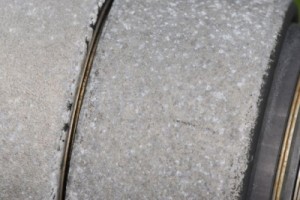
While the natural state aluminum is desirable from a corrosion point of view, many believe the appearance less than attractive
The drawback to this chemic process is the appearance; left to its own devices aluminum also develops shallow pits and a gritty, powdery texture. The byproduct of aluminum's exposure to oxygen is alumina or aluminum oxide, the grit or powder, which acts equally a passivation layer. In and of itself this material isn't harmful and the process is somewhat self-absorbing, unless it's abraded or cleaned away, at which indicate it begins anew. The abrasiveness of aluminum oxide should not be underestimated; it's used in the production of sanding media as its hardness is second only to that of diamonds. Every effort should, therefore be fabricated to prevent it coming in contact with glass, pigment, varnish and other sensitive surfaces. Never dry out wipe one of these surfaces if contaminated with aluminum oxide.
There is one overarching reason for painting aluminum, appearance. While corrosion resistant when left in its natural land many believe its appearance to be unsightly or certainly not as appealing as a smooth, glossy, blotch-gratis two role polyurethane paint. Across that and for anti-fouling purposes (marine growth strikes on aluminum readily), there's little reason to glaze a textile that's naturally corrosion resistant.
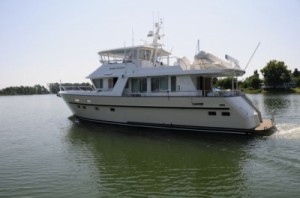
There's little doubt that paint enhances the attractiveness of many recreational aluminum vessels
Aluminum suffers the effects of ii chief types of corrosion, galvanic or dissimilar metal and poultice corrosion. Both varieties of corrosion come into play in marine applications, however, simply poultice corrosion is exacerbated when pigment is added to the mix.
When painted, aluminum's surface is essentially starved of oxygen and as such it's incapable of developing and/or maintaining its corrosion resistant oxide coating. Provided the paint blanket remains contiguous and unbroken this presents no bug, no oxygen and no water means corrosion can't occur. Yet, once the coating is breached, no matter how small or seemingly insignificant that transgression of the coating may be, information technology establishes the recipe for a corrosion cascade. Water ultimately enters the breach, where it reaches and reacts with the aluminum, creating aluminum oxide. The reaction initially has access to air via the breach through which the water passes, still, as the aluminum oxide is formed it expands and lifts the paint, allowing the water to travel further and further from the initial entry point, beneath the paint. Eventually oxygen tin can no longer attain the expanse of interaction, creating an environment ripe for poultice corrosion. The result is the formation of an cruddy blister or bulge, beneath which lurks the byproduct of poultice corrosion, aluminum hydroxide. If yous've never seen it, aluminum hydroxide looks something like freezer burned vanilla water ice cream, information technology'southward oft gooey until the blister'due south surface breaks, at which point information technology volition dry out and revert more than or less to a powdery country.
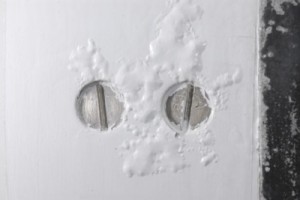
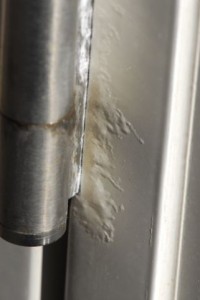
Blisters such as these are a articulate sign that corrosion is occurring under the surface. All the same, it's a symptom of the paint coating having been breached.
When I encounter this all too mutual problem the theory nearly often put forth by professionals and consumers alike is that the aluminum was improperly or inadequately prepared or primed prior to the application of paint. After all, the failure is one of adhesion; the paint has failed to "stick" to the aluminum, right? Although this scenario does occur, information technology is in fact much less common than anecdotal reports would indicate. In well-nigh cases the cause of the corrosive wound is a result of an "injury"; the pigment'southward blanket is breached, allowing h2o to reach a fabric, aluminum, which is initially reactive with air. Once the process begins it's virtually incommunicable to cease.
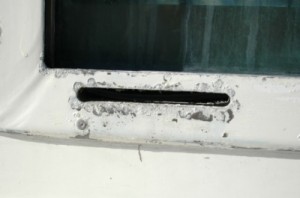
Precipitous, un-radiused corners are notorious for condign the spawning grounds for corrosion
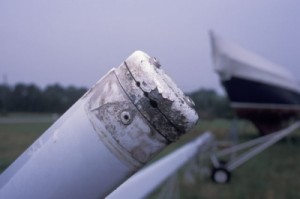
It's no coincidence that the paint failures occur adjacent to hardware, in areas of chafe or where the surface remains moisture, such as, in this case, under a spreader boot.
It'southward important to understand the initial cause of the problem. How does the pigment breach occur? Clearly this can be the result of ordinary wear and tear on aluminum components, a careless worker who, every bit he or she walks by a painted aluminum dinghy crane or door, drags a tool box, hammer or wrench, bear upon with a metallic garden hose nozzle or a dropped boat hook hitting a hatch frame. In my experience, however, fully lxx% of the aluminum hardware paint failures are a effect of hardware installation, with twenty% occurring considering the metallic structure over which the paint is applied contains sharp edges, leading to coatings in these areas whose thickness is inadequate. The remaining 10% are caused by poor preparation or primer application.
Take a look at the painted aluminum hardware on your boat or aboard the next vessel you visit. Nigh invariably the blisters and bubbles begin side by side to hardware or fasteners or in high traffic areas, hatch frames/sills for instance. The surface grooming and paint application are rarely the crusade of the failure; information technology'southward the damage to the coating caused by the hardware during the installation process, or traffic, each screw head, striker plate, each canvass snap, pad eye, hatch handle, access embrace, lock ready, etc. fractures the paint, allowing the poultice corrosion demon to gain a foothold.
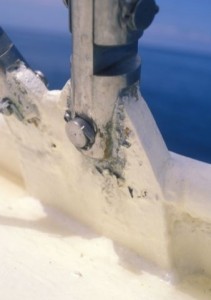
The turnbuckle on the sailing vessel's rig has abraded the paint on the chain plate, leading to severe corrosion. In this example, the interaction between the aluminum and the stainless steel are calculation yet another dimension to the procedure, galvanic corrosion, which will be discussed in an upcoming column
The solution to this problem takes on merely one form, prevention. Once the corrosion has set in any pigment that has already blistered or lifted is doomed, it must be removed and spot repaired or the entire structure must exist repainted. Preventing the problem is exceptionally easy, each and every slice of hardware, every screw and fastener must be bedded in a high quality polyurethane or polysulfide bedding compound. The painted surface and the hardware should each be cleaned and degreased using 3M General Purpose Adhesive Cleaner or mineral spirits. Then, utilize bedding chemical compound to the surface that will make contact with and probable "interruption" the pigment coating. Fastener threads should besides be cleaned and coated, this will prevent galvanic corrosion and the subsequent seizure of the fastener threads. Install the hardware, wipe excess sealant and make clean using the aforementioned product. The sealant will make full paint breaches that occur when the hardware is torqued, preventing h2o entry and the subsequent poultice corrosion.
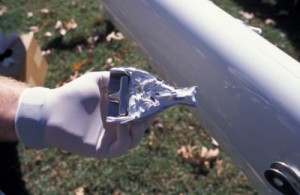
Liberally bedding all hardware that is installed on painted aluminum surfaces with a polyurethane bedding compound will, for the well-nigh function, prevent the paint failure from occurring
Conscientious aluminum boat and hardware builders and installers often insert non-metal shims or insulators betwixt hardware and painted aluminum structures in an try to mitigate harm to the paint every bit well as stemming corrosion resulting from interaction betwixt different metals (I'll cover this discipline in an upcoming cavalcade). While this approach can exist effective and has its place, the insulator will prevent or minimize pigment impairment caused past hardware, it does have its drawbacks. In loftier load scenarios insulators may be crushed or damaged, leading the mechanical failure of the assembly. Additionally, water can migrate between the insulator and the painted surface, where it will exist retained. Because ii part linear polyurethane paints are not designed for continuous immersion, water in this condition will eventually lead to blistering and failure. If insulators are used, they too should be bedded.
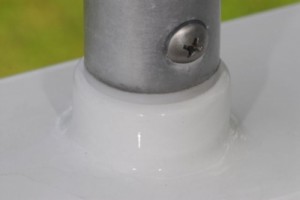
Inserting a not-metal insulator between painted aluminum and other hardware, regardless of its alloy, can preclude pigment damage. However, while beneficial, this arroyo may yet lead to paint failure every bit a result of water entrapment
If the paint is breaching because of "sharp edge failure", the solution to this trouble is a redesign or modification of the assembly, aluminum surfaces over which paint is applied should be rounded or radiused to forbid thin coating areas. Sharp corners, points or edges must exist eliminated.
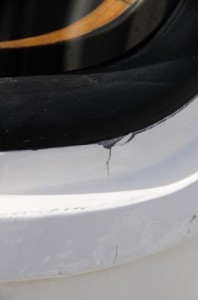
Sharp edged designs have difficulty holding sufficient paint thickness, which ultimately exposes the aluminum, which in turn leads to water migration under the blanket
The longest lasting, lowest maintenance aluminum installations are those that remain unpainted, evidenced by the profusion of bare-hulled rescue, utility, fishing and scientific likewise as select recreational vessels. This holds true of individual deck hardware and equipment including window frames, windlasses and deck hatches. A farther refinement of the un-painted approach involves anodizing, a surface treatment that reduces the formation of aluminum oxide, which improves corrosion resistance and the appearance of aluminum hardware that'south left in its natural state. Given the choice, and where its aesthetics can be accustomed or tolerated, forgoing pigment for anodizing will almost certainly outcome in hardware that looks good now and, more importantly, in years to come.
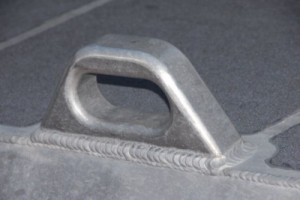
If yous don't heed the appearance, un-painted aluminum offers the greatest corrosion resistance with the least amount of maintenance
Having supervised the painting of many aluminum components, from arches and window frames to masts and unabridged vessels I'm confident of the failure mode too as the solution. Inspect your installations, try the bedding and radiusing approach and I'thou sure you'll pleased with the results.
Copyright 2022 Steve D'Antonio Marine Consulting, Inc. All rights reserved.
For more information on the services provided by Steve D'Antonio Marine Consulting, Inc. please e mail Steve at info@stevedmarineconsulting.com
or call 804-776-0981
Source: https://stevedmarineconsulting.com/paint-and-aluminum-how-to-ensure-a-good-mix-2/
Posted by: velazquezforyinath76.blogspot.com




0 Response to "How To Repair Baked-on Paint On Aluminum Boat Hull"
Post a Comment